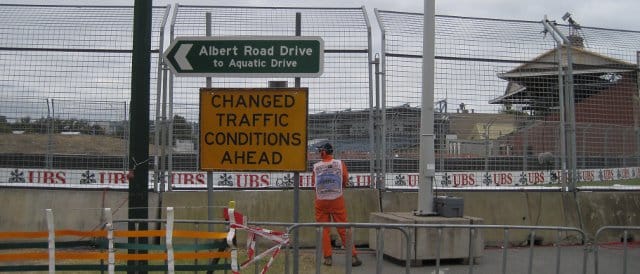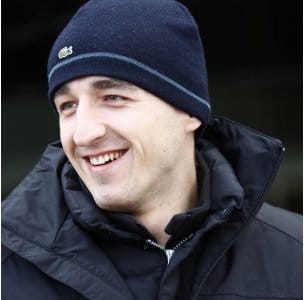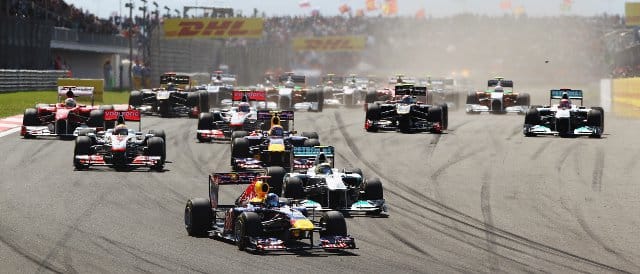
A totally unnecessary sign greets visitors to Albert Park, Melbourne as the 2011 Formula 1 season begins in Australia - Photo Credit: David Bean
In a few years from now, the Formula 1 season of 2011 will probably just be remembered as the season dominated by Sebastian Vettel, in which the German became only the ninth driver in the history of the sport to claim back-to-back titles.
But to summarise the season this straightforwardly does not do justice to the nine months of entertainment witnessed this year. There have been stories from up and down the grid, a number of heroes, the odd villain, and plenty of controversy and politics. Moreover, there have been some fascinating races, unusual incidents and, of course, a few record-breaking moments.
In this mammoth five-part review of the season, we will look back over another good year for the sport, relive some of the most important moments and, finally, look at how 2012 could be even better.

Robert Kubica at the first pre-season test in Valencia, five days before his accident - Photo Credit: Andrew Ferraro/LAT Photographic
Unfortunately, we must begin this review on a sad note, as on Sunday 6th February, we woke to the news that Robert Kubica had been airlifted to hospital after suffering a high-speed accident whilst competing at the Ronde di Andorra Rally in Italy.
Reports later emerged that a metal Armco barrier had penetrated the front of the S2000 Skoda Fabia the Pole had been driving, and he had suffered multiple fractures to his right leg, arm and hand. Surgeons were initially concerned that Kubica might not retain full use of his hand, but recent reports have suggested that the Pole is now recovering well, and determined to get back in an F1 car as soon as possible, although the talented driver will not be back on the grid for the start of the 2012 season.
Tragically, there would be more reminders of the dangers of motor racing later in the year, with the deaths of Dan Wheldon and Marco Simoncelli in Indycar and MotoGP.
In the week before his accident, Kubica had completed the first winter test in Valencia as the fastest driver, and was looking forward to more testing, and to the start of the season. His Renault team, however, now had to head to the second pre-season test in Jerez without their star driver, and were now searching for a replacement. The team trialled Nick Heidfeld and Bruno Senna at the test, and eventually opted for the experienced German for the season ahead.
Heidfeld and Renault had an extra couple of weeks to prepare for the start of the season, as did the rest of the F1 world, when the Bahrain Grand Prix was called-off on 11th February. Originally scheduled as the season opener on the March 14th, the race was first postponed, then bizarrely re-instated, and then cancelled altogether. The reason: bloody anti-government protests taking place in the country. There were huge question marks over the conduct of the Bahrain government, particularly for the attitude and force shown towards what were largely peaceful protestors. Many within F1 were calling for the abandonment of the grand prix on moral grounds, not just safety concerns.
After this difficult end to the winter, the season finally got underway in Australia, with nobody quite sure what to expect. There had been changes galore over the winter, and there was particular intrigue around the new Pirelli tyres after winter testing had shown that the softer compounds were wearing very quickly. There was also the re-introduction of KERS (Kinetic Energy Recovery System) and the new DRS (Drag Reduction System) overtaking-aid, which was to be seen for the first time in the race.
HRT did not benefit at all from the delay to the start of the season, and were assembling their new F111 for the first time during the practice sessions in Melbourne. In qualifying, the team were an embarrassing seven seconds off the front-runner's pace and both Vitantonio Liuzzi and Narain Karthikeyan failed to make the 107% lap time. The stewards did not allow the team to race.
The Spanish team did at least manage to qualify for both the Malaysian and Chinese Grand Prix after the embarrassment in Australia, and looked to be slowly creeping up to the performance shown by their rivals at Virgin Racing.
Meanwhile, Sebastian Vettel stormed to pole position down under with a lap seven-tenths of a second faster than second-placed man Lewis Hamilton could manage. He went on to take the race victory in an equally straightforward drive, with Hamilton taking second. There was a small chink in the Red Bull armour though, as it emerged that Vettel had been denied the use of KERS throughout the race. This gave the whole paddock a glimmer of hope that the RB7, this latest Adrian Newey design, was beatable, despite its dominant display in the hands of Vettel on the opening weekend of the season.
There had been talk of the teams needed four or five stops during the race in Australia, such was the expected fragility of the Pirelli tyres. As it turned out, most drivers required only two changes of tyres, and Sergio Perez, making his F1 debut for Sauber, finished seventh after making just one tyre change. However, the Mexican was denied points at his first race thanks to a technical infringement that saw both him and team-mate Kamui Kobayashi disqualified.
Vitaly Petrov impressed by taking third place for Renault, and Paul di Resta, making his debut for Force India, was promoted to tenth place the Sauber disqualifications.

Petrov feels the spray of champagne after finishing on the podium in Australia - his best result of 2011 - Photo Credit: Lorenzo Bellanca/LAT Photographic
Looking back at the first race of the season, it cannot really be considered a classic, especially when compared to what followed. It did, however, confirm that Red Bull would continue 2011 from where they left off at the end of the previous season, and that no team had really made a huge step forward over the winter.
Although the result at the Malaysian Grand Prix – Vettel took both pole position and the race win once again and, to be honest, it was even more comfortable than his win in Australia – would suggest a similar race, it was actually a completely different spectacle.
The real story from Malaysia concerned the tyres. In the tropical heat of south-east Asia, tyre degradation was running at up to 0.3 seconds a lap and rubber was being shed in chunks, creating the marbles that sat just off the racing line. Even without any significant rain during the race, there were a total of 63 pit stops. The top three – Vettel, Jenson Button and Nick Heidfeld, who collected Renault's second consecutive podium – all managed with just three tyre changes, but Mark Webber, Fernando Alonso and Lewis Hamilton each required four.
Hamilton made his first trip to the stewards in Malaysia – a 20-second penalty was given to the Brit after it was deemed that he had made more than one change of direction whilst defending his position on track. Penalties for Hamilton will quickly become a recurring theme throughout this review. Alonso was also punished for causing a collision with Hamilton.
With the large number of pit stops, and the constant changes in position that resulted, some claimed that the race in Malaysia was just too confusing. Others would argue that it was just a fantastic race, without a single lull in the entertainment. There was more of the same one week later in China.
Vettel took pole position again that weekend, but this time failed to convert it into a victory. Instead, Lewis Hamilton took his first win of the season, overtaking Vettel four laps from the end. Red Bull suffered yet more problems with KERS throughout this weekend – Webber lost use of the power-boost in qualifying, and got knocked-out during Q1, whilst Vettel had intermittent use of the system on race day.
However, it was managing the tyres and choosing the correct pit stop strategy that was the key to success in Shanghai. Hamilton went with three, as did Mark Webber who, after qualifying down in P18, drove an incredible race to finish on the podium. Jenson Button finished fourth; his progress in the race was hampered slightly by an uncharacteristic error on his first pit stop:
The McLaren driver was racing against Webber at the time, and for some inexplicable reason, drove into the Red Bull pit box rather than his own. He realised his mistake, and drove forward to his own team, but this momentary lapse in concentration allowed Webber, who had pitted just behind Button, to take the position from him.

Button found this sight a bit too welcoming as he came in for his first stop in China. Unfortunately, these mechanics were waiting for Mark Webber - Photo Credit: Mark Thompson/Getty Images
Like the race in Malaysia, the Chinese Grand Prix was action-packed from start to finish. There were battles for position up and down the grid as drivers on differing strategies met each other on track with tyres in varying stages of degradation. DRS actually showed what it could do in China, but only after the FIA extended the activation zone by an extra 150 metres. However, with the performance difference brought about by the tyres, one could probably argue that the race would have been just as exciting, and overtaking similarly prevalent, without the adjustable rear-wings.
While Red Bull and McLaren were battling for wins, the season had had not started well for some other teams. Ferrari, for example, had not qualified higher than fifth in the opening three races, and Fernando Alonso's fourth-place finish in Australia was their best result.
At Williams, things were not looking good at all, with the team failing to score any points in the first three races, and neither car even finished the first two events. This caused the team to re-think their technical department, and the resignations of technical director Sam Michael and chief aerodynamicist Jon Tomlinson were announced, effective at the end of 2011.
At the next race in Turkey, pole position was taken, once again, by Sebastian Vettel. He was over four-tenths of a second faster than team-mate Mark Webber in a qualifying session where Red Bull were clearly the class of the field.
On race day in Istanbul, there was an almost-ridiculous 82 pit stops. The top five finishers, including race-winner Vettel, all made four trips into the pit-lane. The German could actually have quite happily taken the win without his fourth change of tyres, as Pirelli said after the race (a story the BBC kindly picked up on their gossip page the next day).

Once Sebastian Vettel had defended his lead from the fast-starting Nico Rosberg, he had no problem taking his third victory of the season - Paul Gilham/Getty Images
Jenson Button paid the price for choosing the wrong strategy – by doing only three stops he was left a sitting duck towards the end of the race. After being passed by team-mate Hamilton and Nico Rosberg during the final few laps, the 2009 champion eventually had to settle for sixth place.
DRS actually played a big part during the race in Turkey. After the first couple of races were it had been almost completely ineffective, the FIA lurched to the other extreme in Istanbul, creating an activation zone that was far too long, meaning that overtaking was too easy.
There was no sense of any struggle, and drivers could happily sit behind another for most of the lap, just preparing to pounce once there were on the straight. There were 126 overtaking manoeuvres at the Turkish Grand Prix, a new record for a Formula 1 race. The degrading tyres obviously contributed to this as well, but with DRS helping cars to sail past one another with ease, this total was made a little excessive.
Vettel was not complaining though. With three wins and one second place finish in the first four races of the season, he left Turkey with a championship lead of 34 points. Lewis Hamilton was second.
Despite the domination from Vettel, however, many fans loved the new style of racing. The multiple pit stops and constant changes in position may have required a bit of extra concentration, and lulls in action that allowed time to make a cup of tea seemed to be a thing of the past, but it was genuinely exciting and, apart perhaps from the identity of the eventual race winner, the action was largely unpredictable.
But F1 was now heading to a couple of tracks generally known for processional racing. The races in Spain and Monaco would be a real test for the new regulations. In Part 2, we look at how these events panned out, recall a particularly difficult race for Hamilton, and re-live what was arguably the finest race of 2011.



